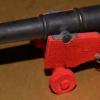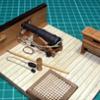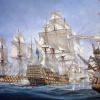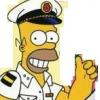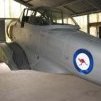-
Posts
1,763 -
Joined
-
Last visited
Reputation Activity
-
 Mark P reacted to BANYAN in What are these? does anybody knows? thanks.....
Mark P reacted to BANYAN in What are these? does anybody knows? thanks.....
The beauty of the internet and the great collective experience we have on this site - thanks for the explanation Gerard (we learn things every day) and thanks Big Mac for raising the sugject.
cheers
Pat
-
 Mark P got a reaction from popeye the sailor in What are these? does anybody knows? thanks.....
Mark P got a reaction from popeye the sailor in What are these? does anybody knows? thanks.....
Greetings everyone;
With regard to this object being a counterweight, I do not think this is very likely, as it is on the longer part of the yard. A counterweight would need to be on the shorter part to balance the additional length of the longer arm. At least, if it was countering the weight of the yard this would be so. If it was somehow intended to counter a force exerted by the wind this could be different, but a rope would seem the easiest way of countering the wind.
Would a weight at this point be advantageous or disadvantageous when changing tack? How is a lateen sail handled when manoeuvring?
Could it be intended to act as a damper, taking some of the spring out of the yard that could arise due to its length, especially during a change of tack?
There is no sign of any rope reeving through it on any of the illustrations shown (although that could, of course, be artistic licence) so a truck for flag halliards seems unlikely. Especially as one vessel is shown with a flag at the masthead. Although, certainly, the absence of flags from the yard-arm does not prove anything in this case.
More food for thought, I hope.
All the best,
Mark P
-
 Mark P got a reaction from BANYAN in What are these? does anybody knows? thanks.....
Mark P got a reaction from BANYAN in What are these? does anybody knows? thanks.....
Greetings everyone;
With regard to this object being a counterweight, I do not think this is very likely, as it is on the longer part of the yard. A counterweight would need to be on the shorter part to balance the additional length of the longer arm. At least, if it was countering the weight of the yard this would be so. If it was somehow intended to counter a force exerted by the wind this could be different, but a rope would seem the easiest way of countering the wind.
Would a weight at this point be advantageous or disadvantageous when changing tack? How is a lateen sail handled when manoeuvring?
Could it be intended to act as a damper, taking some of the spring out of the yard that could arise due to its length, especially during a change of tack?
There is no sign of any rope reeving through it on any of the illustrations shown (although that could, of course, be artistic licence) so a truck for flag halliards seems unlikely. Especially as one vessel is shown with a flag at the masthead. Although, certainly, the absence of flags from the yard-arm does not prove anything in this case.
More food for thought, I hope.
All the best,
Mark P
-
 Mark P got a reaction from mtaylor in What are these? does anybody knows? thanks.....
Mark P got a reaction from mtaylor in What are these? does anybody knows? thanks.....
Greetings Gerard;
Many thanks for the explanation. That's completely logical once it is made clear, as with so many things.
All the best,
Mark P
-
 Mark P got a reaction from BIGMAC in What are these? does anybody knows? thanks.....
Mark P got a reaction from BIGMAC in What are these? does anybody knows? thanks.....
Greetings Gerard;
Many thanks for the explanation. That's completely logical once it is made clear, as with so many things.
All the best,
Mark P
-
 Mark P reacted to BIGMAC in What are these? does anybody knows? thanks.....
Mark P reacted to BIGMAC in What are these? does anybody knows? thanks.....
Thanks for your interest Mark. Indeed many question marks. During my pre-building research, I have saved this graph of a lateen sail handling (its from a building post on this site, unfortunately dont remember which one), but i dont find any answers yet....Dumper? buffering control?
-
 Mark P got a reaction from BIGMAC in What are these? does anybody knows? thanks.....
Mark P got a reaction from BIGMAC in What are these? does anybody knows? thanks.....
Greetings everyone;
With regard to this object being a counterweight, I do not think this is very likely, as it is on the longer part of the yard. A counterweight would need to be on the shorter part to balance the additional length of the longer arm. At least, if it was countering the weight of the yard this would be so. If it was somehow intended to counter a force exerted by the wind this could be different, but a rope would seem the easiest way of countering the wind.
Would a weight at this point be advantageous or disadvantageous when changing tack? How is a lateen sail handled when manoeuvring?
Could it be intended to act as a damper, taking some of the spring out of the yard that could arise due to its length, especially during a change of tack?
There is no sign of any rope reeving through it on any of the illustrations shown (although that could, of course, be artistic licence) so a truck for flag halliards seems unlikely. Especially as one vessel is shown with a flag at the masthead. Although, certainly, the absence of flags from the yard-arm does not prove anything in this case.
More food for thought, I hope.
All the best,
Mark P
-
 Mark P got a reaction from grsjax in What are these? does anybody knows? thanks.....
Mark P got a reaction from grsjax in What are these? does anybody knows? thanks.....
Greetings everyone;
With regard to this object being a counterweight, I do not think this is very likely, as it is on the longer part of the yard. A counterweight would need to be on the shorter part to balance the additional length of the longer arm. At least, if it was countering the weight of the yard this would be so. If it was somehow intended to counter a force exerted by the wind this could be different, but a rope would seem the easiest way of countering the wind.
Would a weight at this point be advantageous or disadvantageous when changing tack? How is a lateen sail handled when manoeuvring?
Could it be intended to act as a damper, taking some of the spring out of the yard that could arise due to its length, especially during a change of tack?
There is no sign of any rope reeving through it on any of the illustrations shown (although that could, of course, be artistic licence) so a truck for flag halliards seems unlikely. Especially as one vessel is shown with a flag at the masthead. Although, certainly, the absence of flags from the yard-arm does not prove anything in this case.
More food for thought, I hope.
All the best,
Mark P
-
 Mark P got a reaction from mtaylor in What are these? does anybody knows? thanks.....
Mark P got a reaction from mtaylor in What are these? does anybody knows? thanks.....
Greetings everyone;
With regard to this object being a counterweight, I do not think this is very likely, as it is on the longer part of the yard. A counterweight would need to be on the shorter part to balance the additional length of the longer arm. At least, if it was countering the weight of the yard this would be so. If it was somehow intended to counter a force exerted by the wind this could be different, but a rope would seem the easiest way of countering the wind.
Would a weight at this point be advantageous or disadvantageous when changing tack? How is a lateen sail handled when manoeuvring?
Could it be intended to act as a damper, taking some of the spring out of the yard that could arise due to its length, especially during a change of tack?
There is no sign of any rope reeving through it on any of the illustrations shown (although that could, of course, be artistic licence) so a truck for flag halliards seems unlikely. Especially as one vessel is shown with a flag at the masthead. Although, certainly, the absence of flags from the yard-arm does not prove anything in this case.
More food for thought, I hope.
All the best,
Mark P
-
 Mark P got a reaction from Canute in Wales
Mark P got a reaction from Canute in Wales
Greetings dallen; gentlemen;
I am glad to know that several people found my post useful.
Mike: the reason for the gradual reduction in the sheer of a ship seems to be that the higher the bow and stern are built, the more they catch the wind, with the result that the ship will heel over more easily, and make more leeway.
In earlier centuries, it was considered an advantage to have one's decks higher than those of an enemy, for the purpose of shooting down at them with bows or spears etc, whilst it was much harder for the enemy to respond. Shipwrights therefore curved the hull upwards as much as they could. As cannon became more important in warfare, this height became less important, and performance considerations drove a gradual flattening.
Improved construction techniques developed under Robert Seppings, chief surveyor to the Navy, led to the ability to build longer ships that were less likely to hog due to the greater strength of their hull structure, thus removing the last reason to build with an upward curve. Ships could then be made with little or no sheer.
All the best,
Mark P
-
 Mark P got a reaction from Canute in Wales
Mark P got a reaction from Canute in Wales
Hi dallen;
To answer your question in general terms, relating to British/American warships:
The wales were lengths of planking which were considerably thicker than the general exterior planking of a ship, and so projected beyond the face of the other planks, which makes them obvious features on both drafts and models.
The main wale normally followed the line of the widest part of the ship's body, known as the line of maximum breadth. On the majority of British and American vessels, this was mostly vertical amidships, and changed profile towards the bow and stern.
As Jaager remarks above, the wale was intended to counter-act 'hogging' or the tendency of the bow and stern to curve downwards over time, leading to curvature of the keel and affecting the ship's performance. This was caused by a combination of over-loading the ship at these points, normally with too many/too heavy cannon, and by the fact that when at sea, the movement of the waves often means that the ends of the vessel are not as deep in the water as the midships, leaving the ends less well supported.
As a way of increasing the effectiveness of the wales in resisting this hogging tendency, the wales were curved upwards at each end more sharply than the decks curved upwards.
Ships normally had one wale per deck, with the main wale the lowest, and those above diminishing in size.
The method of constructing the wales varied considerably over time, and is one of the diagnostic features used to help date models in Museums and other collections.
The upward curvature of the ship at each end is known as the 'sheer', and was much greater in earlier centuries than in more modern times, decreasing gradually, until by the first quarter of the Victorian era, most vessels were almost straight from end to end.
All the best,
Mark P
-
 Mark P got a reaction from Mike Y in Wales
Mark P got a reaction from Mike Y in Wales
Greetings dallen; gentlemen;
I am glad to know that several people found my post useful.
Mike: the reason for the gradual reduction in the sheer of a ship seems to be that the higher the bow and stern are built, the more they catch the wind, with the result that the ship will heel over more easily, and make more leeway.
In earlier centuries, it was considered an advantage to have one's decks higher than those of an enemy, for the purpose of shooting down at them with bows or spears etc, whilst it was much harder for the enemy to respond. Shipwrights therefore curved the hull upwards as much as they could. As cannon became more important in warfare, this height became less important, and performance considerations drove a gradual flattening.
Improved construction techniques developed under Robert Seppings, chief surveyor to the Navy, led to the ability to build longer ships that were less likely to hog due to the greater strength of their hull structure, thus removing the last reason to build with an upward curve. Ships could then be made with little or no sheer.
All the best,
Mark P
-
 Mark P got a reaction from Matrim in Wales
Mark P got a reaction from Matrim in Wales
Hi dallen;
To answer your question in general terms, relating to British/American warships:
The wales were lengths of planking which were considerably thicker than the general exterior planking of a ship, and so projected beyond the face of the other planks, which makes them obvious features on both drafts and models.
The main wale normally followed the line of the widest part of the ship's body, known as the line of maximum breadth. On the majority of British and American vessels, this was mostly vertical amidships, and changed profile towards the bow and stern.
As Jaager remarks above, the wale was intended to counter-act 'hogging' or the tendency of the bow and stern to curve downwards over time, leading to curvature of the keel and affecting the ship's performance. This was caused by a combination of over-loading the ship at these points, normally with too many/too heavy cannon, and by the fact that when at sea, the movement of the waves often means that the ends of the vessel are not as deep in the water as the midships, leaving the ends less well supported.
As a way of increasing the effectiveness of the wales in resisting this hogging tendency, the wales were curved upwards at each end more sharply than the decks curved upwards.
Ships normally had one wale per deck, with the main wale the lowest, and those above diminishing in size.
The method of constructing the wales varied considerably over time, and is one of the diagnostic features used to help date models in Museums and other collections.
The upward curvature of the ship at each end is known as the 'sheer', and was much greater in earlier centuries than in more modern times, decreasing gradually, until by the first quarter of the Victorian era, most vessels were almost straight from end to end.
All the best,
Mark P
-
 Mark P got a reaction from mtaylor in Wales
Mark P got a reaction from mtaylor in Wales
Greetings dallen; gentlemen;
I am glad to know that several people found my post useful.
Mike: the reason for the gradual reduction in the sheer of a ship seems to be that the higher the bow and stern are built, the more they catch the wind, with the result that the ship will heel over more easily, and make more leeway.
In earlier centuries, it was considered an advantage to have one's decks higher than those of an enemy, for the purpose of shooting down at them with bows or spears etc, whilst it was much harder for the enemy to respond. Shipwrights therefore curved the hull upwards as much as they could. As cannon became more important in warfare, this height became less important, and performance considerations drove a gradual flattening.
Improved construction techniques developed under Robert Seppings, chief surveyor to the Navy, led to the ability to build longer ships that were less likely to hog due to the greater strength of their hull structure, thus removing the last reason to build with an upward curve. Ships could then be made with little or no sheer.
All the best,
Mark P
-
 Mark P got a reaction from -Dallen in Wales
Mark P got a reaction from -Dallen in Wales
Greetings dallen; gentlemen;
I am glad to know that several people found my post useful.
Mike: the reason for the gradual reduction in the sheer of a ship seems to be that the higher the bow and stern are built, the more they catch the wind, with the result that the ship will heel over more easily, and make more leeway.
In earlier centuries, it was considered an advantage to have one's decks higher than those of an enemy, for the purpose of shooting down at them with bows or spears etc, whilst it was much harder for the enemy to respond. Shipwrights therefore curved the hull upwards as much as they could. As cannon became more important in warfare, this height became less important, and performance considerations drove a gradual flattening.
Improved construction techniques developed under Robert Seppings, chief surveyor to the Navy, led to the ability to build longer ships that were less likely to hog due to the greater strength of their hull structure, thus removing the last reason to build with an upward curve. Ships could then be made with little or no sheer.
All the best,
Mark P
-

-
 Mark P reacted to -Dallen in Wales
Mark P reacted to -Dallen in Wales
Druxey, Jagger, Mark, Anthony, Mike and Allanyed;
What a response and education! Thank you Jagger and Mark for your eloquent and informative narrative concerning the wale. Thank you Allanyed for your research material. All the information and research data will become part of my running "Deck Log" that will detail my entire voyage as a builder. Druxey, my broad type and era target would be 19th century American/British warships with focus on Frigates. Tweets and flurishes to you all.
dallen0121
-
 Mark P got a reaction from mtaylor in Wales
Mark P got a reaction from mtaylor in Wales
Hi dallen;
To answer your question in general terms, relating to British/American warships:
The wales were lengths of planking which were considerably thicker than the general exterior planking of a ship, and so projected beyond the face of the other planks, which makes them obvious features on both drafts and models.
The main wale normally followed the line of the widest part of the ship's body, known as the line of maximum breadth. On the majority of British and American vessels, this was mostly vertical amidships, and changed profile towards the bow and stern.
As Jaager remarks above, the wale was intended to counter-act 'hogging' or the tendency of the bow and stern to curve downwards over time, leading to curvature of the keel and affecting the ship's performance. This was caused by a combination of over-loading the ship at these points, normally with too many/too heavy cannon, and by the fact that when at sea, the movement of the waves often means that the ends of the vessel are not as deep in the water as the midships, leaving the ends less well supported.
As a way of increasing the effectiveness of the wales in resisting this hogging tendency, the wales were curved upwards at each end more sharply than the decks curved upwards.
Ships normally had one wale per deck, with the main wale the lowest, and those above diminishing in size.
The method of constructing the wales varied considerably over time, and is one of the diagnostic features used to help date models in Museums and other collections.
The upward curvature of the ship at each end is known as the 'sheer', and was much greater in earlier centuries than in more modern times, decreasing gradually, until by the first quarter of the Victorian era, most vessels were almost straight from end to end.
All the best,
Mark P
-
 Mark P got a reaction from -Dallen in Wales
Mark P got a reaction from -Dallen in Wales
Hi dallen;
To answer your question in general terms, relating to British/American warships:
The wales were lengths of planking which were considerably thicker than the general exterior planking of a ship, and so projected beyond the face of the other planks, which makes them obvious features on both drafts and models.
The main wale normally followed the line of the widest part of the ship's body, known as the line of maximum breadth. On the majority of British and American vessels, this was mostly vertical amidships, and changed profile towards the bow and stern.
As Jaager remarks above, the wale was intended to counter-act 'hogging' or the tendency of the bow and stern to curve downwards over time, leading to curvature of the keel and affecting the ship's performance. This was caused by a combination of over-loading the ship at these points, normally with too many/too heavy cannon, and by the fact that when at sea, the movement of the waves often means that the ends of the vessel are not as deep in the water as the midships, leaving the ends less well supported.
As a way of increasing the effectiveness of the wales in resisting this hogging tendency, the wales were curved upwards at each end more sharply than the decks curved upwards.
Ships normally had one wale per deck, with the main wale the lowest, and those above diminishing in size.
The method of constructing the wales varied considerably over time, and is one of the diagnostic features used to help date models in Museums and other collections.
The upward curvature of the ship at each end is known as the 'sheer', and was much greater in earlier centuries than in more modern times, decreasing gradually, until by the first quarter of the Victorian era, most vessels were almost straight from end to end.
All the best,
Mark P
-
 Mark P got a reaction from Mike Y in Wales
Mark P got a reaction from Mike Y in Wales
Hi dallen;
To answer your question in general terms, relating to British/American warships:
The wales were lengths of planking which were considerably thicker than the general exterior planking of a ship, and so projected beyond the face of the other planks, which makes them obvious features on both drafts and models.
The main wale normally followed the line of the widest part of the ship's body, known as the line of maximum breadth. On the majority of British and American vessels, this was mostly vertical amidships, and changed profile towards the bow and stern.
As Jaager remarks above, the wale was intended to counter-act 'hogging' or the tendency of the bow and stern to curve downwards over time, leading to curvature of the keel and affecting the ship's performance. This was caused by a combination of over-loading the ship at these points, normally with too many/too heavy cannon, and by the fact that when at sea, the movement of the waves often means that the ends of the vessel are not as deep in the water as the midships, leaving the ends less well supported.
As a way of increasing the effectiveness of the wales in resisting this hogging tendency, the wales were curved upwards at each end more sharply than the decks curved upwards.
Ships normally had one wale per deck, with the main wale the lowest, and those above diminishing in size.
The method of constructing the wales varied considerably over time, and is one of the diagnostic features used to help date models in Museums and other collections.
The upward curvature of the ship at each end is known as the 'sheer', and was much greater in earlier centuries than in more modern times, decreasing gradually, until by the first quarter of the Victorian era, most vessels were almost straight from end to end.
All the best,
Mark P
-
 Mark P got a reaction from MartinB in Wales
Mark P got a reaction from MartinB in Wales
Hi dallen;
To answer your question in general terms, relating to British/American warships:
The wales were lengths of planking which were considerably thicker than the general exterior planking of a ship, and so projected beyond the face of the other planks, which makes them obvious features on both drafts and models.
The main wale normally followed the line of the widest part of the ship's body, known as the line of maximum breadth. On the majority of British and American vessels, this was mostly vertical amidships, and changed profile towards the bow and stern.
As Jaager remarks above, the wale was intended to counter-act 'hogging' or the tendency of the bow and stern to curve downwards over time, leading to curvature of the keel and affecting the ship's performance. This was caused by a combination of over-loading the ship at these points, normally with too many/too heavy cannon, and by the fact that when at sea, the movement of the waves often means that the ends of the vessel are not as deep in the water as the midships, leaving the ends less well supported.
As a way of increasing the effectiveness of the wales in resisting this hogging tendency, the wales were curved upwards at each end more sharply than the decks curved upwards.
Ships normally had one wale per deck, with the main wale the lowest, and those above diminishing in size.
The method of constructing the wales varied considerably over time, and is one of the diagnostic features used to help date models in Museums and other collections.
The upward curvature of the ship at each end is known as the 'sheer', and was much greater in earlier centuries than in more modern times, decreasing gradually, until by the first quarter of the Victorian era, most vessels were almost straight from end to end.
All the best,
Mark P
-
 Mark P got a reaction from PeteB in Wales
Mark P got a reaction from PeteB in Wales
Hi dallen;
To answer your question in general terms, relating to British/American warships:
The wales were lengths of planking which were considerably thicker than the general exterior planking of a ship, and so projected beyond the face of the other planks, which makes them obvious features on both drafts and models.
The main wale normally followed the line of the widest part of the ship's body, known as the line of maximum breadth. On the majority of British and American vessels, this was mostly vertical amidships, and changed profile towards the bow and stern.
As Jaager remarks above, the wale was intended to counter-act 'hogging' or the tendency of the bow and stern to curve downwards over time, leading to curvature of the keel and affecting the ship's performance. This was caused by a combination of over-loading the ship at these points, normally with too many/too heavy cannon, and by the fact that when at sea, the movement of the waves often means that the ends of the vessel are not as deep in the water as the midships, leaving the ends less well supported.
As a way of increasing the effectiveness of the wales in resisting this hogging tendency, the wales were curved upwards at each end more sharply than the decks curved upwards.
Ships normally had one wale per deck, with the main wale the lowest, and those above diminishing in size.
The method of constructing the wales varied considerably over time, and is one of the diagnostic features used to help date models in Museums and other collections.
The upward curvature of the ship at each end is known as the 'sheer', and was much greater in earlier centuries than in more modern times, decreasing gradually, until by the first quarter of the Victorian era, most vessels were almost straight from end to end.
All the best,
Mark P
-
 Mark P got a reaction from AntonyUK in Wales
Mark P got a reaction from AntonyUK in Wales
Hi dallen;
To answer your question in general terms, relating to British/American warships:
The wales were lengths of planking which were considerably thicker than the general exterior planking of a ship, and so projected beyond the face of the other planks, which makes them obvious features on both drafts and models.
The main wale normally followed the line of the widest part of the ship's body, known as the line of maximum breadth. On the majority of British and American vessels, this was mostly vertical amidships, and changed profile towards the bow and stern.
As Jaager remarks above, the wale was intended to counter-act 'hogging' or the tendency of the bow and stern to curve downwards over time, leading to curvature of the keel and affecting the ship's performance. This was caused by a combination of over-loading the ship at these points, normally with too many/too heavy cannon, and by the fact that when at sea, the movement of the waves often means that the ends of the vessel are not as deep in the water as the midships, leaving the ends less well supported.
As a way of increasing the effectiveness of the wales in resisting this hogging tendency, the wales were curved upwards at each end more sharply than the decks curved upwards.
Ships normally had one wale per deck, with the main wale the lowest, and those above diminishing in size.
The method of constructing the wales varied considerably over time, and is one of the diagnostic features used to help date models in Museums and other collections.
The upward curvature of the ship at each end is known as the 'sheer', and was much greater in earlier centuries than in more modern times, decreasing gradually, until by the first quarter of the Victorian era, most vessels were almost straight from end to end.
All the best,
Mark P
-
 Mark P got a reaction from Archi in HMS Terror found!
Mark P got a reaction from Archi in HMS Terror found!
Thanks Druxey;
Having seen your post, I had a look, and there are some interesting news articles about it on line.
All the best,
Mark P
-
 Mark P got a reaction from Canute in Red Paint or Red Ochre
Mark P got a reaction from Canute in Red Paint or Red Ochre
Greetings gentlemen;
I have a feeling that the red paint used was actually red lead, which has some anti-bacterial, or anti-fungal properties, and is still often used as a primer for wooden boats. This paint is, I believe, more hard-wearing than one based on red-ochre. However, this is based on a feeling that I read this somewhere. I will check up on this and see if I can find something more concrete than a feeling.
All the best,
Mark P


